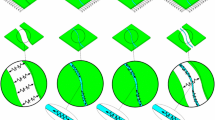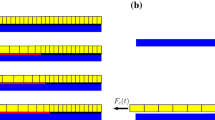Abstract
A cohesive zone type interface model, taking full account of finite geometry changes, is used to study the decohesion of a viscoplastic block from a rigid substrate. The specific boundary value problem analyzed is a plane strain one with the imposed loading corresponding to overall uniaxial straining. The imperfection takes the form of a non-bonded portion of the interface. Dimensional considerations introduce a characteristic length into the formulation and the decohesion mode shifts from more or less uniform separation along the bond line to crack-like propagation as the ratio of block size to characteristic length increases. Field distributions prior to and accompanying propagation are displayed.
Similar content being viewed by others
References
A. Needleman, Journal of Applied Mechanics 54 (1987) 525–531.
A. Needleman, “A Numerical Study of Void Nucleation at Carbides”, in Innovations in Ultrahigh-Strength Steel Technology, Proceedings of the 34th Sagamore Army Materials Research Conference, to be published.
S.R. Nutt and A. Needleman, Scripta Metallurgica 21 (1987) 705–710.
S.R. Nutt, in Interfaces in Metal-Matrix Composites, A.K. Dhingra and S.G. Fishman (eds.), The Metallurgical Society of AIME, Metals Park, OH (1986) 157–167.
J.H. Rose, J. Ferrante and J.R. Smith, Physical Review Letters 47 (1981) 675–678.
G.I. Barenblatt, Advances in Applied Mechanics 7 (1962) 56–129.
D.S. Dugdale, Journal of the Mechanics and Physics of Solids 8 (1960) 100–104.
J.R. Rice, in Proceedings of the 8th National Congress of Applied Mechanics, R.E. Kelly (ed.), ASME, New York (1979) 191–216.
J.D. Achenbach, L.M. Keer, R.P. Khetan and S.H. Chen, Journal of Elasticity 9 (1979) 397–424.
M. Ortiz and J.A. Blume, International Journal of Fracture 42 (1990) to be published.
T. Ungsuwarungsri and W.G. Knauss, International Journal of Fracture 35 (1987) 221–241.
J.R. Rice, Journal of Applied Mechanics 35 (1968) 379–386.
J.D. Eshelby, in Progress in Solid State Physcis, Vol. 3, F. Seitz and D. Turnbull (eds.), Academic Press, New York (1956) 79–144.
C.F. Shih and R.J. Asaro, Journal of Applied Mechanics 55 (1988) 299–316.
T.-L. Sham, in Elastic Plastic Fracture: Second Symposium, Vol. 1-Inelastic Crack Analysis, C.F. Shih and J.P. Gudas (eds.) STP 803, American Society for Testing and Materials, Philadelphia (1983) 52–79.
W.J. Drugan, J.R. Rice and T.-L. Sham, Journal of the Mechanics and Physics of Solids 30 (1983) 447–473.
Author information
Authors and Affiliations
Rights and permissions
About this article
Cite this article
Needleman, A. An analysis of decohesion along an imperfect interface. Int J Fract 42, 21–40 (1990). https://doi.org/10.1007/BF00018611
Received:
Accepted:
Issue Date:
DOI: https://doi.org/10.1007/BF00018611




